Your Falling School Roll – The Sure Fire Fix
A ‘How To’ Case Study
You have a falling school roll.
It’s causing a whole range of problems, not least of which is that your school funding is dropping with every passing year.
That brings with it the spectre of even less money to cover your essential overheads for each new year, and a potential downward spiral of reduced funding in coming years.
In turn, parents may well end up voting with their feet if they feel the decrease in school funding has affected the provision of the education that their child deserves. When that happens the problem just gets progressively more serious for your school.
All too often this is happening to schools who know that there’s no immediate hope of a change.
Or is there?
Well, yes there is and it’s really very simple.
Here’s How To Fix the Falling Roll at Your School
In most cases of a school with a falling roll, there is a simple and effective fix.
Here it is.
Advertise.
But, hang on.
We’ll get to that in a minute.
I’m afraid you don’t just chuck up a few ads and expect a flood of applications to come out the other end.
There’s a bunch of ducks you need to get all in a row first!
Even though that is the basic strategy. And it’s not very hard to do, either.
Of course there’s a few things you need to get straight, and we’ll cover the exact steps you need to take in the detail of the case study below, which will help you understand this diagram.

Attracting Admissions to Your School – Who Will This Work For?
The basic truth is that you will struggle to attract parents and their pupil children to your school if there simply aren’t enough children in your local area.
The falling roll is especially difficult to tackle in remote rural areas where low pupil numbers in large geographical areas mean that the total available school age population and therefore the maximum enrolment in any given year is well below average class size.
Schools finding themselves in this situation will usually be eligible for additional funding to keep small rural schools open and should look to strategies that are specifically aimed at targeting this issue.
Similarly, if your school has a poor Ofsted rating and there’s plenty of competing schools nearby that have better reports, then you’re facing an uphill battle. You’re not beaten, but you’ll need to really find your strengths and market those to your unique advantage to overcome that competition and potentially negative first impression.
Of course, many schools with a poor Ofsted report are well on the way to huge improvement and you can highlight that, but just be warned that your job is harder than it would otherwise be.
So, everybody else – any school with a good or outstanding Ofsted report in any area of the country.
This strategy will work to increase your school place applications.
If the primary reason that you’re not getting enough applications to your school is that there are more places available than are needed locally, because you have a plentiful supply of schools in your catchment area, then your job is simply to do a better job than your rival schools.
You’re the perfect candidate to implement the strategy in this case study and reverse your falling roll in one enrolment period.
In other words, you should be able to fill your available class spaces for the next school year.
What is the Cost to Your School of a Falling Roll?
Although the exact mechanics of school funding differ depending on your Local Authority and are changing with the introduction of the National Funding Formula, let’s assume that every pupil in a Primary School (which is the case study) attracts funding to your school of approximately £4,000 per year (in line with the Education Policy Institute Report).

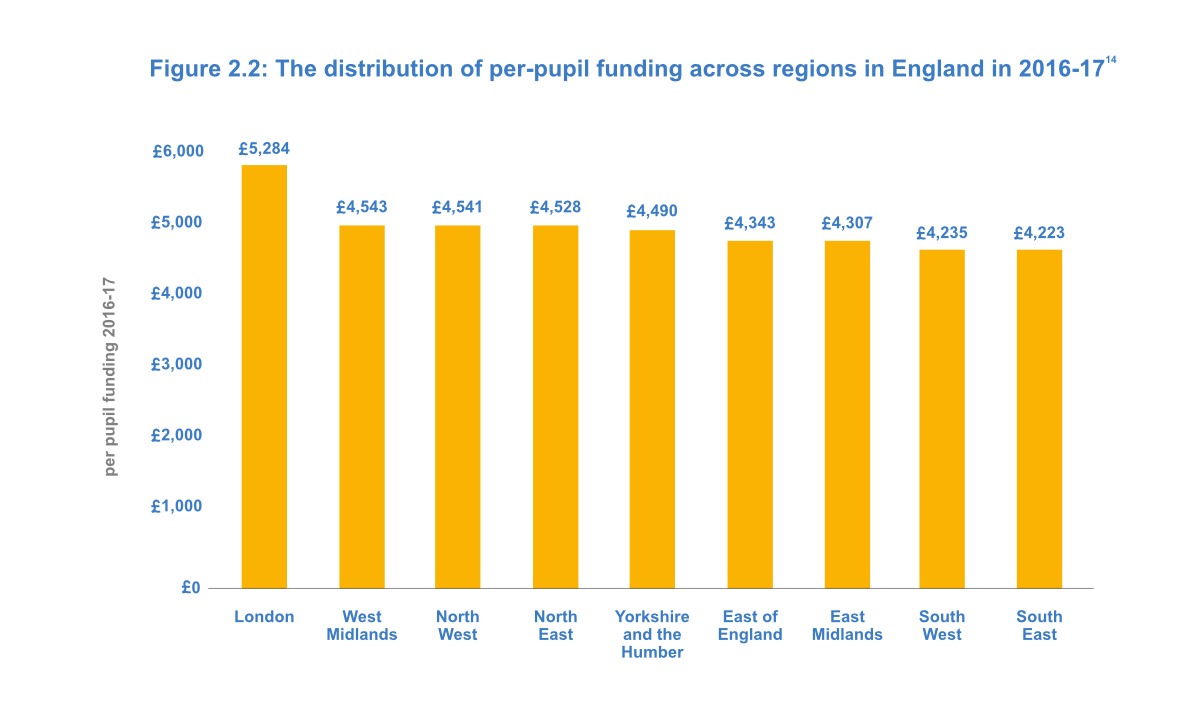

Now, clearly, having that funding per pupil means you’ll be spending it providing their education and care, so we can’t just treat additional pupils as ‘extra money’, but nonetheless, the ‘per pupil funding’ does make a significant contribution to your school’s overall budget.
So, if you are one pupil short of your capacity in Reception, that’s £4,000 (or more) you’re not getting in that financial year.
Worse, over the six years a single pupil isn’t in your primary school and you carry forward a smaller class, that’s a £24,000 hole in your budget.
Now, let’s assume you’re having an ongoing problem with your falling roll, which is exactly the downward trend we often see and was the situation in our case study.
If you are short of your full class size by four pupils, then you’ve missed out on a minimum of £16,000 in pupil funding in that first year but a quite terrifying £96,000 in the full six years of a child’s primary education.
And, we all know how little movement there usually is into established classes in the years following Reception. It happens, but not a lot, so when you’ve missed your class enrolment target in Reception you’re likely to be stuck with that underfunding for six long years.
Not that I want to make you squirm even more, but supposing that happens every year because you don’t find a solution to your falling roll problem – what then?
Well, in that case you’ll be missing out on that kind of funding in every year over the whole six years – and my back of a napkin maths makes that well over £300,000 in lost funding over the six year period.
Further, a study by the Mayor of London shows that demand for Primary School places in London peaks in 2019 and will steadily fall in future years. This will clearly cause further pressure on schools with falling rolls to compete for new pupils.
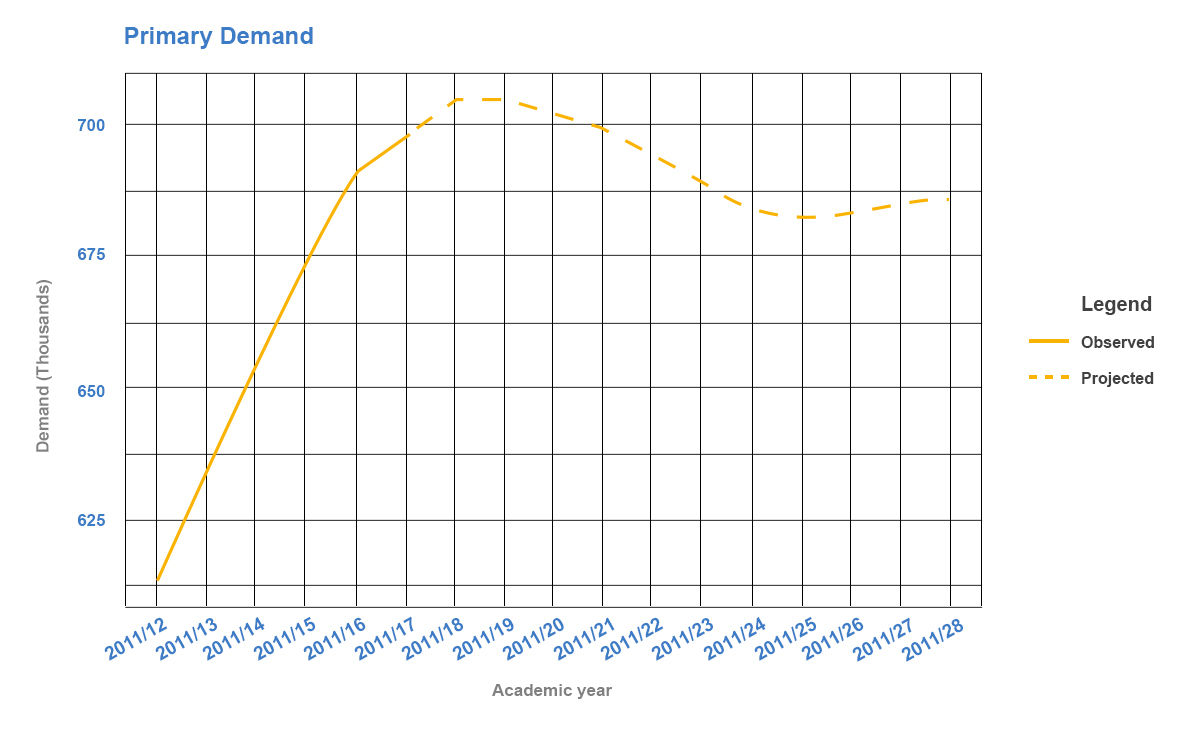
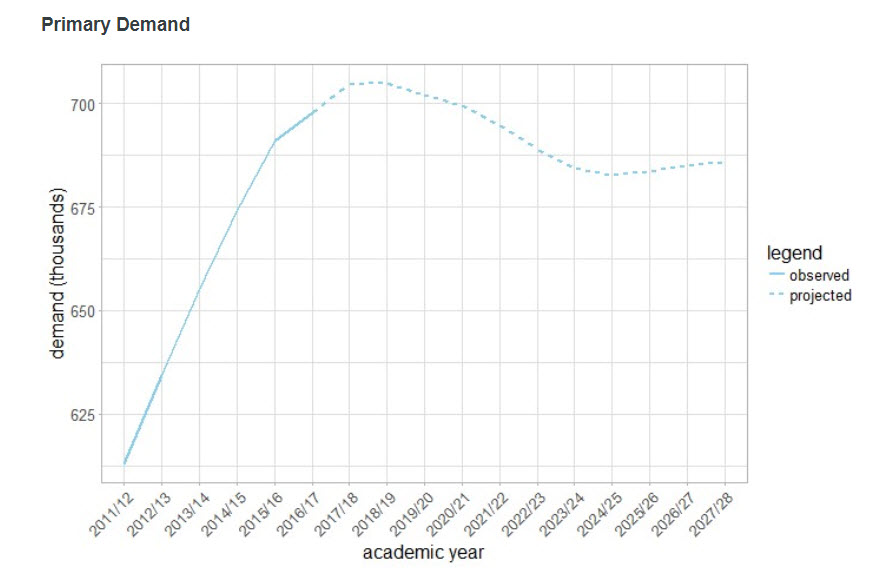

Data shows that this pattern is repeated across the country and that our future relationship with Europe may well have an additional negative affect for struggling schools as numbers of school age children fall across the UK in line with falling immigration.
In other words, for schools that struggle to attract new pupils, things are going to get worse, not better!
'FIX YOUR FALLING SCHOOL ROLL' CHECKLIST
Get the entire strategy we used to double this school's admissions in an easy to follow step-by-step checklist. Click here.
How to Increase Enrolment in Your School
(The Primary School Case Study)
Whilst the example we’re covering here is a Primary School in central London, this approach will work for any suitable school, whether Primary, Secondary or all-through and wherever they are in the country.
What Was the Problem Facing This Primary School?
St Andrew’s C of E Primary in Lambeth is an Ofsted ‘Good’ school with an excellent local reputation, but suffered from a lack of local awareness.
This is partly because this ‘hidden gem’ of a school is exactly that, hidden away on a quiet residential street. It has a single form entry and unless you know it’s there it’s crowded out by the larger competing schools in the area.
As a single form entry school St Andrews target is to have a full class of 30 new pupils in Reception.
Unfortunately in 2017 they had just 22 children join in Reception and in 2018 they had 26.
They could not afford to let this go on.
We already worked with the school, having built their website, so we were their first port of call when they were trying to find out if digital marketing could help them fix their problem.
We were sure it could – and so it proved.
Step 1 – Understand the Problem and Assess the Parental Decision Making Process
We started by seeking to understand the problem faced by the school.
Why was their class size falling and what were the root causes?
To fix the problem we needed to find out what motivated parents to choose or reject this school as their preferred option for their children entering Reception.
By talking to existing parents and prospective parents we established what had influenced their decision to choose the school and what other concerns they felt were primary factors in making their choice.
We also used our software tools to conduct keyword research so that we learnt what people search for in search engines when they are trying to choose the right school for their children.
In addition, we turned to the latest research by a Cambridge University project that looked at exactly the problem our case study school was facing; ‘What factors influence parental preference of schools, and what are the outcomes of those preferences?'
This proved to be a goldmine of information.
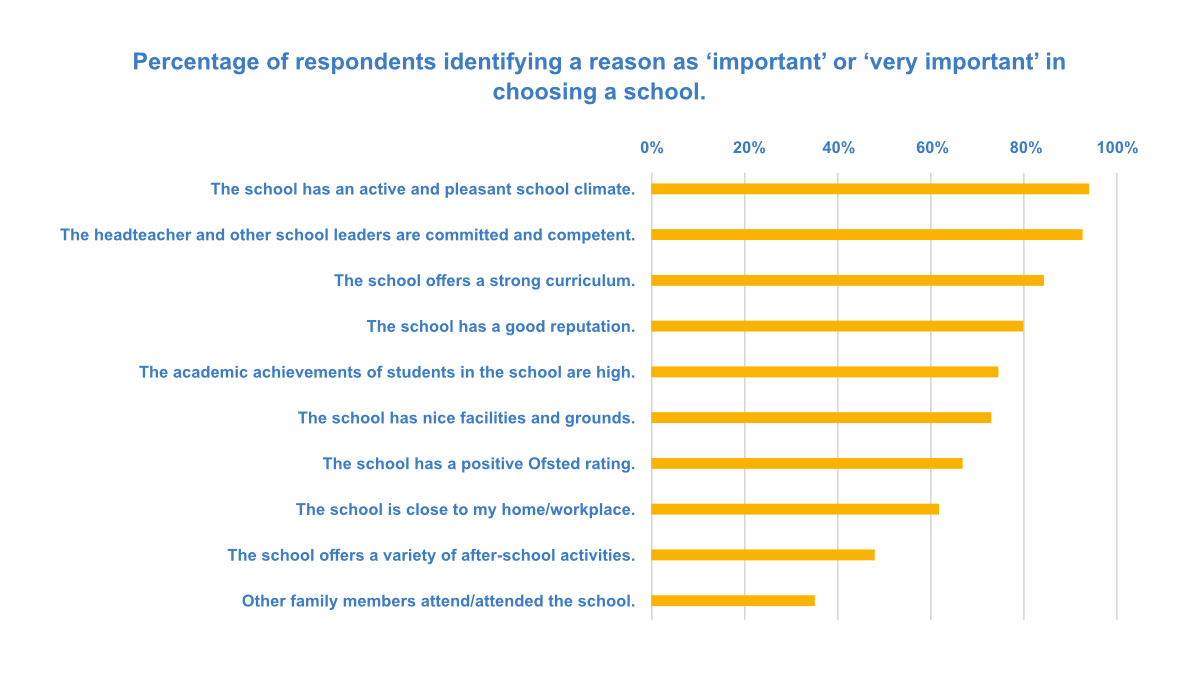
Of course, we all assume that parents are looking at the standard of education as their first concern (and the Ofsted report in particular) when they choose their child’s school.
This is clearly the case for a very high proportion of parents, but they are also taking into account other concerns and priorities, information (accurate or not) that they hear from friends and family, and the overall local reputation of the school.
Unless they hear something negative about your school, the fact of the matter is that there’s a large section of the parental population who will feel that a Good Ofsted report is sufficient in regard to what it covers, as long as they hear other good things from other sources.
That’s not to hide from the fact that very many parents will do all they can to enrol their child in a school with an Outstanding report.
However, such schools are very unlikely to have a falling roll problem and are likely to be massively oversubscribed meaning that parents who can’t meet the location (or other eligibility) criteria are going to be looking elsewhere in any event.
For St Andrews school in our case study, we discovered that many parents of existing pupils had been persuaded to enrol their child because the school has a Good Ofsted report, because other parents speak very highly of the school and many spoke of liking the small family feel and inclusivity.
This was in line with the research of the Cambridge study, which also showed us what sources of information affected parental choice, helping us to decide where to focus our marketing efforts.

In our research, it emerged that St Andrew's was very capable of selling its unique selling points and had the Ofsted report to back it up, as long as they could reach enough local parents of Reception age children in the first place.
The main problem they faced was that many parents in the area just didn’t know the school existed and, if they did, they hadn’t heard why it would be a good choice for their child.
We also learned that a lot of potential parents had other pressing needs when it came to choosing a school (both from in person research and by studying search engine results).
Many with long working hours needed a school with strong extended childcare. As St Andrew’s has a breakfast club and an after school club, we knew this needed to be highlighted.
Other unique selling points of the school that parents liked were the one form entry that meant all children quickly got to know all the teachers and staff (and vice versa) and which helps to make the school small and friendly. There was also interest in the fact that the school has a 200 year history, which suggests longevity and resilience, qualities the parents admired.
Armed with this information, we could then plan a marketing campaign that focused on raising awareness and amplifying the reputation of the school in the local community, while directly addressing the key concerns.
Step 2 – Update the School Website to Target the Needs of Prospective Parents
As we’d built the St Andrews school website previously we knew where the content was weak in getting these points across.
So our first action in the campaign was to make content updates on various pages of the website, rewriting the ‘Admissions’ page to explain the process of applying to this particular school, adding a new page about the ‘Extended Childcare’ available and updating the pages about each of the Breakfast Club and After School Clubs.
In each case, we wrote the copy to be informative and persuasive as well as designing and writing them so that they had a chance ranking in Google searches for relevant terms.
Although we didn’t carry out extensive search engine optimisation (since that is a longer term and more expensive strategy) we did optimise the new and updated pages using ‘on-site SEO’ methods.
We also took the decision to create two additional pages based on our keyword research.
We had discovered that parents searched for ‘best primary schools in Lambeth’ and ‘how to apply for a primary school place in Lambeth’ and variations of those queries, so we made a page on the St Andrew’s website that satisfied each of these searches as well.
Where appropriate we also inserted ‘social proof’ into all these pages using quotes from existing parents and pupils that were, of course, positive about the school and were relevant to that page’s content.
Even implementing the most basic of search engine optimisation principles can see your pages have some presence in search results.



The page we created for ‘how to apply for a Primary School place in Lambeth’ walked parents right through the process of using the Lambeth online ‘Primary Schools Admission Portal’, with step by step explanation and images as well as a video. The idea was that we could take parents through the entire process with a helpful article that no other school had as a marketing asset.
Our website analytics tool tells us that 33 people read through that page in detail during the application period.
Whilst that might not sound like many, we know that each of those visitors was highly motivated as they spent a long time on the page. We cannot be certain that any of those 33 ended up applying to the school, but it is highly likely.
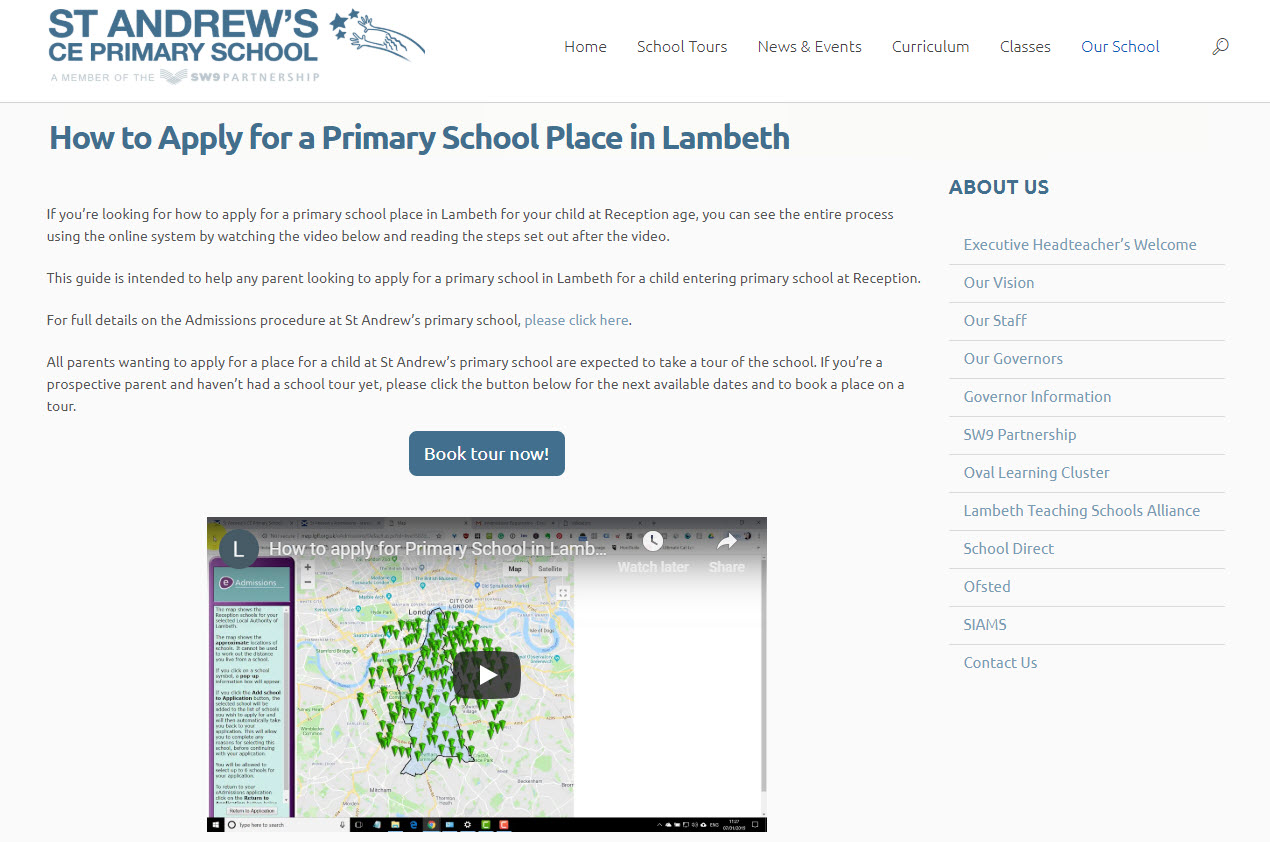


At the very least, we know that this is a page on the St Andrews website that will continue to be a valuable resource in forthcoming years. In addition, we started work on an ‘FAQ’ page, which we’ll use extensively in future year’s campaigns. This directly answers all the main questions that the school hear from their prospective parents on their tours and will also become a valued resource. We suggest getting a comprehensive FAQ page in place for your school as soon as possible.
Over the next few years we hope that these pages will naturally pick up links (which helps with search ranking) and we will do additional work to assist their performance so that they become more prominent in search results. This was not the primary aim in this initial campaign as we simply didn’t have the time or budget to make them work using organic traffic, but, as you’ll see, we used both of these pages in our ad campaigns.
Step 3 – The School Can Sell Itself When Parents Know About it – So, Focus on School Tours!
We noted earlier that, as is the case in many schools, if the staff at St Andrews can get prospective parents through the door to have a guided tour of the school, then often that’s enough to persuade a parent and make St Andrews their number one choice.
The reality is that all parents are busy so they might not have the time to visit all the schools on their shortlist, so you need to make sure that your school is one that they do visit, and, critically, you need to make sure that the tour is as persuasive as possible.
In order to make this happen, the number one thing that we did in our website updates and additional page creation is that we added buttons on all those pages that linked to another newly created page that focused entirely on getting parents to take the School Tour.
We used language that agitated the prospective parent to come and visit the school:
“As places at our school are in high demand and many open mornings are fully booked, we advise booking as soon as possible."
"We strongly encourage all prospective parents and carers to visit the school before applying for a place for your child.”
And, in the whole of the Autumn term, we ensured that the school would hold a tour once a week (and, in fact, they will now be holding at least one per month all year round).
Parents looking at any of the updated pages (whether they landed there from a Google search or an ad) would see a prominent button to book a school tour and would then be encouraged to do so by this language on the school tour page.
We then created a new page for each available date of the school tours and enabled parents to book a place with just their name and an email address on the site.
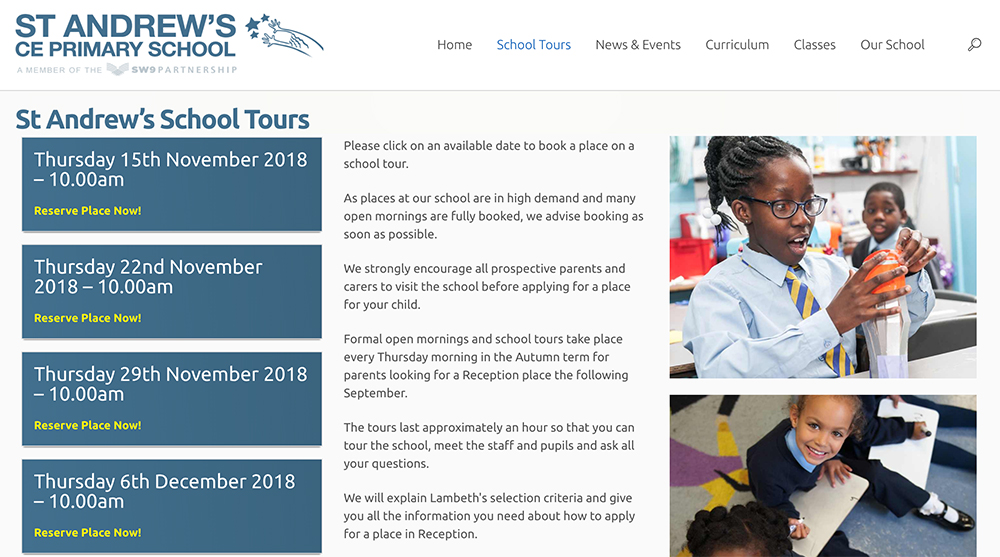
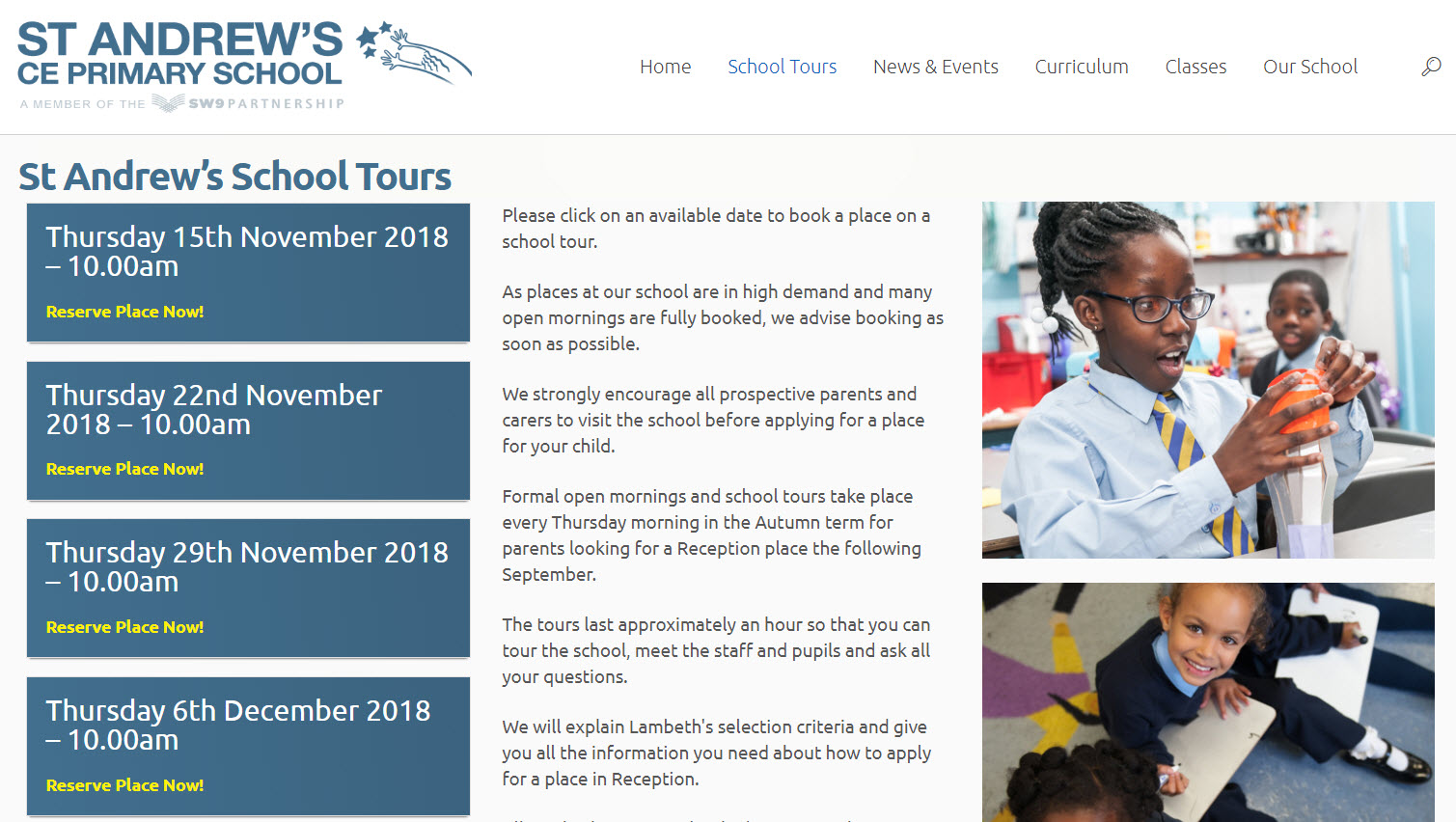

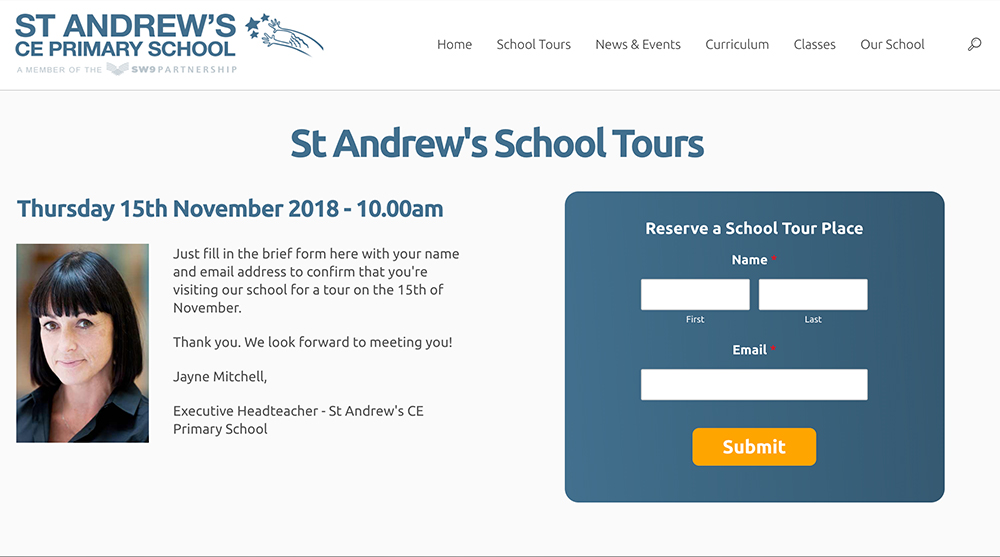
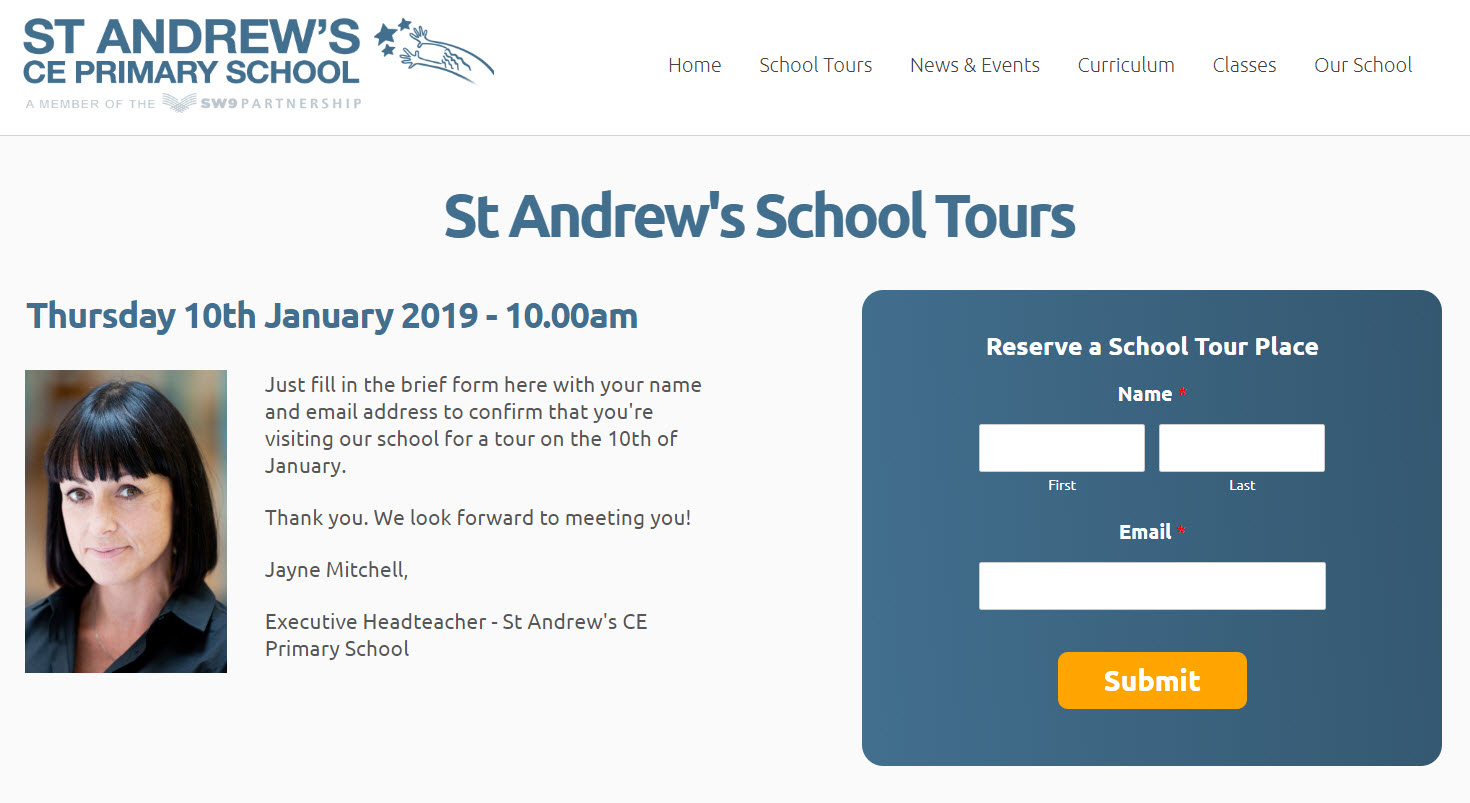

Once they did so, they saw a page confirming that they were booked on the tour for the date they chose and the school office was notified automatically of their name, email and date of the tour.
In the initial year of this campaign more than 90% of the parents registering for a school tour in this way turned up, but we are considering creating an automated email follow up sequence in future years that will remind the parent the day before to ensure they come on the tour.
This system would also allow us to follow up by email automatically urging people to ask the school any remaining questions and to make sure they completed their application before the deadline, as well as sending out emails automatically to prospective parents with other relevant information about joining the school (such as sending them to read the new and updated pages we created).
More importantly, such an automated follow up system would keep the school ‘top of mind’ during the parent’s application research and decision making process.
In the event, St Andrews didn’t need this to get the fantastic result they did in their first year of using this digital marketing campaign (and it was outside their budget) but it’s worth thinking about for the future for them and might be necessary for your school to drive maximum applications.
Step 4 – How Do You Get Parents Interested in Your School?
The new pages on the site were groundwork for getting the result that St Andrews wanted.
We knew we needed to answer the questions parents had and we needed to raise the awareness of the school with people who had children of Reception age in the local area.
We’d already done some of this by optimising the new and updated pages to appear in search results.
But, that wouldn’t be enough to reach every parent in the area.
This is where we get to the advertising.
'FIX YOUR FALLING SCHOOL ROLL' CHECKLIST
Get the entire strategy we used to double this school's admissions in an easy to follow step-by-step checklist. Click here.
How Can You Advertise for School Admissions?
This is the secret sauce.
You need to have put a ‘mechanic’ in place that you can track, which in our case study is the school tour page and booking system. Having a confirmation page which parents are sent to after they completed their form meant that we would be able to track exactly who reacted to which ad and whether they booked a tour or not (using tracking pixels from each ad platform).
Knowing this meant that we were able to test different ads on different advertising platforms and shift the school’s budget to those ads that were driving school tour sign ups.
Note – in the unlikely event that you control your own admission process fully on your school website – not the case for St Andrews as they used the Lambeth Portal – then you can track in even greater detail and see exactly which ad you run leads to people submitting a school place application.
Google Adwords Advertising for School Enrolment
Since we didn’t have the budget or time to deliver top rankings in Google for our new pages, we first placed ads in the top of the search results using Google Adwords.
This meant that anyone in the area (a two mile radius) around the school searching for any of the keywords we researched earlier (e.g. ‘primary school place Lambeth’, ‘best primary Lambeth’) would see our ad.
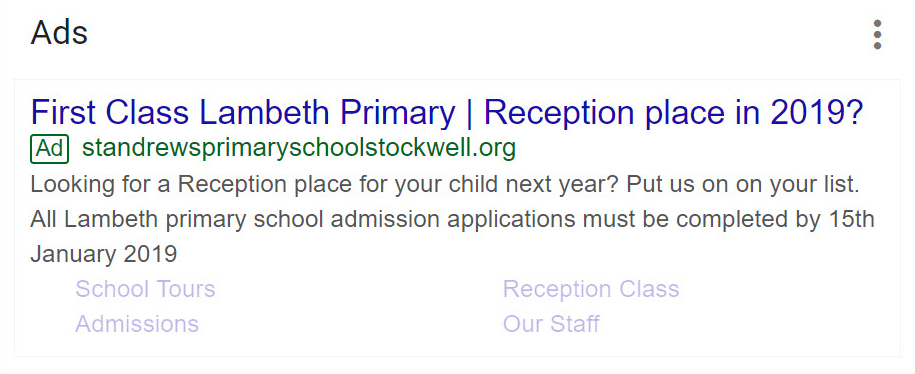
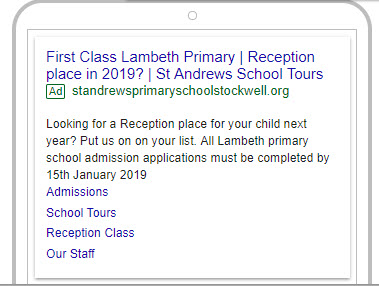

If they clicked through (as more than one hundred did) we’d send them either directly to the school tour page or, on occasion whilst running tests, to the ‘best primary’ page, which itself, of course, linked through to the school tour page.
The total ad spend for this campaign was under £60 – an astonishingly small sum to ensure that the right parents who are actively searching for a school for their child know about your school and click through to your site!



In many ways we saw the Adwords campaign as a simple ‘mopping up’ exercise. We wanted it in place as SEO hadn’t had time to take effect and rank our targeted pages organically, but we wanted a powerful presence at the top of the Google results.
And it was clearly effective.
Facebook Advertising for School Applications
However, our focus was always going to be on social advertising campaigns, so we concentrated our efforts on Facebook and Instagram.
The targeting options on Facebook (which also powers ads on Instagram) are so powerful that they simply cannot be ignored.



Our primary initial targeting was to people in a two mile radius of the school who Facebook knew had children between the age of 3 and 5.
Crazy, but true. Facebook knows this about its users so you should use it.
I know that means you’re also running ads to parents of children who are at least a year away from entering school (the three year olds), but that makes no odds for two reasons.
If they are thinking ahead, parents of a three year old might already be thinking about primary school for their child so your ad spend isn’t entirely wasted and, secondly, because you pay only for the click (and not the impression or view) it doesn’t matter if your ad reaches a small number of uninterested people since they are unlikely to click.
We started with ads on Facebook that we thought would stand out in the News Feed with images that weren’t just of the school or pupils studying.
In this example, we used an image of ducklings and equated the sentiment of the ad to the care the school would give to their future pupils.
We tested this type of short copy ad with different images and to different destination pages on the school website, using a variety of the pages we’d built.
We also used a great video that the school already had which simply showed the school and pupils engaging in their education.
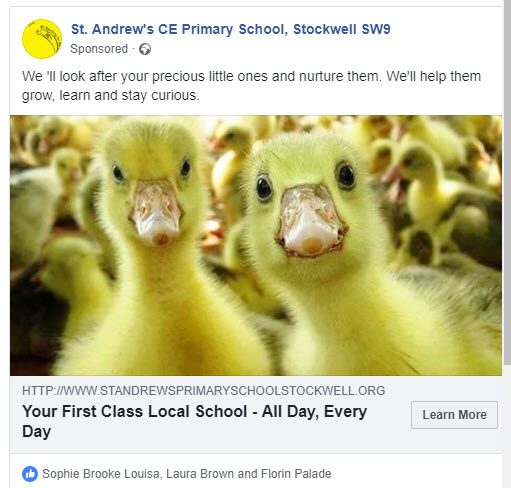


This ad was again targeted to the same demographic, using Facebook’s targeting options, and people who clicked were sent to one or other of the new pages.



It quickly became apparent that the most successful landing page for the majority of the ad creative that we were testing was the school tour page.
Clearly our persuasive copy was doing the trick!
Learning this as the campaign evolved, we set most of our direct ads so that clicking on them took a parent straight to the tour page.
It seemed that the combination of the ad and that page was enough to get a proportion of visitors to immediately book their school tour – in the region of 12% depending on which ad they had clicked on.



Once a parent chose a date from the list on the left of the page they went to a booking page specific to that date.



If they then followed through and entered their name and email they would get to a page that simply confirmed their application for a school tour had been received.
Because we had added a Facebook (and a Google Adwords) pixel to the whole of the St Andrew’s site, we were able to track who completed that journey and who didn’t get past either of the school tour pages.
Those people who didn’t end up booking a tour but who had seen these pages, were added to what Facebook calls a ‘Custom Audience’ so that we could run a further set of ads just to these people.
You’ll be familiar with this technique if you’ve ever been ‘stalked’ around the internet by an advert for something you were looking at the day before.
It is incredibly powerful because retargeting potential parents using this type of ad is cheaper than any other form of advertising and normally brings higher conversions.
In this case, we ran similar ads to bring people in this Custom Audience back to the St Andrew's site. Since all the new pages had links to the tour page we were able to send these returning visitors to other pages to get more information about Admissions, the after school club and so on.
We weren’t done with ads yet though!



Another element of the Facebook ad campaign was that we also created one Facebook Event for all of the available school tour dates and then promoted this to the same targeting – both the 3-5 year old’s local parents, and the Custom Audiences of people who had already visited the school website.
This ad received a number of responses where people stated that they were ‘interested’ and a number of clicks over to the school tour page.
Lastly, when we were running into the last week or so before primary school place applications had to be in on Facebook, we ran a series of ads (with various images but largely the same copy) that called out the approaching deadline and highlighted the urgency.
In other words, we were really pushing people to complete their application before the deadline, and, hopefully, to list St Andrew's as their first choice.
From these deadline ads we sent all traffic to the ‘How to apply’ page so that we’d be giving a helping hand to those who had left things to the last minute.
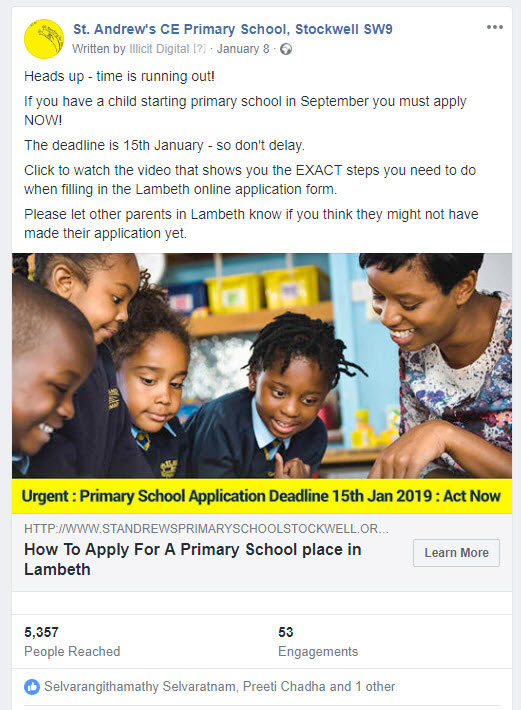
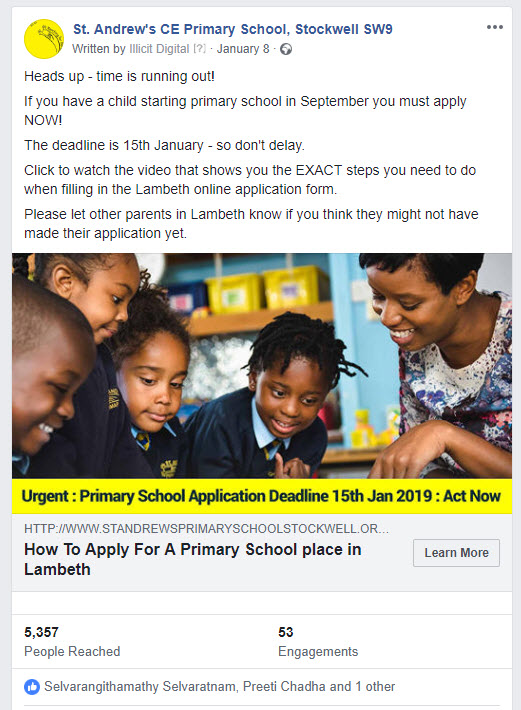

Instagram Advertising to Increase School Place Applications
But we weren’t finished yet.
To be honest, we were getting great results from Facebook ads and we knew we were getting bookings on the school tours because our Facebook Ad Manager account was showing us those conversions.
Therefore, using Instagram ads wasn’t absolutely necessary, but, if you don’t test, you won’t know!
And we just had to know if there was an even better performing ad that we might be able to find on Instagram.
Short answer – there wasn’t!
But one ad in particular was worth the bother of creating it.
We tried some static images on Instagram with similar copy to the Facebook ads but their results were not as strong as similar ads on Facebook.
So, instead we shot a simple 60 second video of the headteacher talking to camera about the school and edited in footage from their school promotional video, and formatted the video to the native square format of Instagram.
We wrote a basic script for this video that called out the unique selling points of the school that we knew appealed to parents from our research – the one form entry, the small village nature of the school and so on.
In the video, the head says how much she’d like parents to come and take a look around the school, meet the teachers and pupils, ask questions and then, crucially, at the end of the video the head specifically asks people to click the link and book a tour.
We posted this video as a video ad on Instagram and it earned well over 500 views and 43 clicks direct through to the school tour page.
We would consider trying a lot more variants of this kind of ad on Instagram for your school if time and budget allowed.
We did also try the latest ad format available on Instagram – the Instagram Story ad.
These use vertical video or images and appear in the Instagram Story.
Our results for this were dismal!
Again we had shot a video of the head, this time using vertical video but, with a much shorter script since these ads only allow for 15 seconds of footage.
We never really got any traction at all on this ad when targeting the same audiences (our 3-5 year old’s parents and our Custom Audience).
We haven’t really established why this didn’t work. In fact, we spent a massive £0.27 on this particular ad and there was clearly some problem with the delivery since the Facebook ad platform should have allowed us to spend much more to reach more people.
In other words, the jury’s out on Instagram Story ads for this particular objective for schools.
There’s probably a campaign that will work, but we didn’t find it this time!
Lookalike Audiences for Facebook and Instagram Ads for School Place Enrolment Ads
The last element of our campaigns that we should mention is that, right at the end of the campaign, we tried Lookalike Audiences on Facebook.
These are created by Facebook when you are able to give it data on a Custom Audience and ask Facebook to find more people like those.
As we were creating Custom Audiences of people who visited various pages, including those who had successfully made a school tour booking, we asked Facebook to create a Lookalike Audience of people who most closely matched those.
Our sample size was very small, but Facebook was able to create a Lookalike audience and in the last week we ran our best performing ‘deadline approaching’ ad to this audience.
As it was too late for school tour bookings we can’t really be sure how this performed but we know it received some clicks and our anecdotal evidence suggests that it may have even driven an application or two (remember that we can’t track actual applications as they happen off site).
'FIX YOUR FALLING SCHOOL ROLL' CHECKLIST
Get the entire strategy we used to double this school's admissions in an easy to follow step-by-step checklist. Click here.
How Much Did the Facebook and Instagram Advertising Cost?
Again, the total cost of the advertising was surprisingly small.
That makes sense since St Andrews were really only targeting a few thousand hyper local people (who they knew had Reception age children). We know from the Facebook data when setting up the ads that this was, in fact, between 1,500 and 3,800 depending on whether we targeted a 1 mile or 2 mile radius of the school.
Facebook tells us that the ‘frequency’ of the ads that we ran was often as high as 4. This is the average number of times someone you’re targeting will see your ad whilst it’s running.
Often we try to keep that frequency number from going above 1 so that people don’t keep seeing the same ad, but when you have a very small target number of people and a message that is critical for them to review we think it was acceptable to let them see some of the ads this often.
We were, after all, really trying to drive them to action.
The overall spend on all the Facebook and Instagram ads came in at a fraction under £1,000 - £999.82 to be precise.


That means the total combined ad spend when the Google Adwords spend of £59.46 is added in, comes to £1059.28.
How Effective was the Falling School Roll Campaign?
Here’s the payoff.
St Andrews had less than its maximum class size in all recent years.
In 2017 they’d had 22 pupils enter Reception and in 2018 they had 26.
This was causing a serious long-term funding crisis for the school.
This campaign finished on 15th January 2019 and at the time of writing St Andrews has 97 applications of which 38 are first choice.
In other words, in 2019 they will have a full class of 30, no matter what.
And therefore, they will have secured the maximum funding per pupil and will do so with this class for the next six years.
By any measure, we came very close to doubling the number of applications and we hit the key target of filling the class.
Year On Year St Andrew's Reception Place Data
2017
2018
2019
The fact that we ended up with more applications than places is a nice bonus for the future as we can now refer to the school as ‘oversubscribed’ in next year’s campaign, which we’re sure we can use to encourage more people to apply for Reception places in 2020, for fear of missing out.
More importantly, how much additional funding has been secured for St Andrews for 2019, the ensuing six years and how much easier will their future enrolment be?
Well, we know we’ve added at least £16,000 in additional funding next year. And, over the next six years, somewhere between £96,000 and more than £300,000 as per my maths at the start of this case study.
As the head teacher of St Andrews pointed out at the start of the campaign, if we delivered one more pupil than in previous years, we would just about cover the cost of the campaign immediately (of course there’s our fee to consider which pushes the overall campaign cost to a little over £5,000).
It’s also well worth remembering that no-one can know how many pupils might or might not have been enrolled without the campaign.
All we can do is point to the 83% increase in applications following the campaign and note that we know how many clicks were sent to the school website and how much engagement the ads drove.
It’s a shame that we can’t measure how many of the applications came about as a direct result of the campaign, but empirically we have to assume that it was the campaign that created that increase and will now give this school peace of mind moving forward in future years.
What Can You Learn From This Case Study?
All marketing campaigns are like that. You have to think about what you believe will work and then you use your ad creative and copy to test it out.
We didn’t do much of that with Adwords, but got some great results.
Facebook ads clearly performed very well and delivered the majority of the clicks and school tour bookings.
What worked best on Facebook?
Definitely creating a Facebook Event and running an Event Response ad is worth doing, as is testing multiple ad creatives, copy and images until you find the ones that work.
The ad targeting is simple because of the data that Facebook makes available. If you’re running a primary school, just do what we did.
If you’re trying to increase applications to a Secondary, simply target the age bracket for that in Facebook’s ad targeting options. You’ll be limited to parents with children aged 8-12 in that instance, but there are other options you can use to narrow that down.
We’d definitely recommend a native square video on Instagram with the head talking directly to prospective parents as that worked well for us and we’re sure there’s something that will work in Instagram Story ads given more time.
When Should You Start School Admissions Marketing Campaign
Our campaign started in August but we spent the first couple of months researching and then creating pages, so our ads didn’t start running until November.
In future years we’ll be offering school tours for St Andrews throughout the year (ramping up between September and January) and we’ll be running ad campaigns from late August.
If your school needs to take action on a falling roll, now is the time to start, especially if you need to learn some basic Facebook and Adwords advertising skills.
Moreover, really getting to grips with the reasons why your school has a falling roll, establishing what your schools unique selling points are (and what made existing parents choose your school) and then building and updating the necessary pages and systems (especially a trackable school tour booking system) will all take time to do properly.
If I was asked to advise a school that had a falling roll about when to start advertising in year one of their attempts to fix their problem, I’d say, ‘start now!’.
St Andrews has the luxury of knowing they have a system that’s worked. If you’re coming to this now, don’t wait until September. Get your system in place and start running ads as soon as possible.
What Would We Do Differently for Falling Roll Campaigns?
We’ll be taking this approach forward for St Andrews and for a handful of schools who’ve heard about the success we’ve had through the grapevine.
Since it’s been a success and achieved its sole aim, we won’t be doing much differently for that particular school.
But, for other schools, we’ll go right back to the start, define the problem and test solutions – both this one that has worked for one school and variations that we think might deliver results in other situations.
The two things that we’d highlight that we didn’t do in this campaign, but which we do use in other work we do in different industries, are using urgency and having a clear follow up strategy, because these two things very often increase conversions.
So, we’d look to create a sense of urgency that isn’t just about getting an application for a child’s place in before the deadline. Wherever we could, we’d look to introduce that urgency around different stages of the process. We’d point out that there’s a limit to the number of tours we can do, so book sooner rather than later.
We’d think about offering to assist in applications to people who get in quick, and we’d definitely run even more follow up ads to people who might have visited any page of the school website in the previous year. Those people might be existing parents, but they could well be people researching schools as well – especially those who read the Admissions pages – and we can track them specifically and retarget them later.

Jayne Mitchell
Headteacher - St Andrew's
"The success of this campaign far exceeded our expectations. We couldn't let our falling school roll problem continue so we put our faith in the plan that Illicit Digital devised. They exceeded our expectations and fixed our problem! For next year we'll be adding some additional ideas they've had to automate our interactions with parents to make the process even more effective. We'll also be using Illicit to help us grow the applications at our other school in the SW9 Partnership."
The other thing that we think will make a real difference in most cases is establishing a clear visitor follow up strategy.
We looked at that earlier on when pointing out that you could add an email automation system to follow up with anyone who has booked a tour. Both to email them to make sure they turn up on the day, and to follow up after the tour pointing out dates they need to stick to for their application and so on. In our case budget and time prevented us doing this in the case study, but we’ll aim to have this in place for the next enrolment cycle.
But, if you can’t implement such an email strategy, can you do follow up phone calls? If you didn’t collect an email and telephone number at the enquiry stage, can you get one at the school tour and follow up with, ‘Is there anything we can do to help you with your application?’.
Whatever it is, we feel that although this isn’t strictly in the realm of digital marketing, it’s somewhere a lot of schools could probably improve. The hardest part is getting a prospective parent to be aware of and looking into choosing your school.
Once you’ve done that, you don’t want to let them forget about you. As we’ve seen, ads are a great way to do that, but adding in email or phone calls can only make it even more effective.
What Are You Waiting For?
We’ve proven that this exact strategy has fixed a falling roll problem for St Andrews.
This year their Reception class will be full and they’ll enjoy the maximum amount of per pupil funding as a result – this year and for the next six.
The cost of making this change was covered by the application of one additional pupil and will be covered tens of times over in the next six years because of the ongoing additional funding.
You can follow these exact steps and put something similar in place for your school, right now.
Problem solved.
If you would prefer to have us bring our specific experience from this successful campaign to your school and fix your falling roll problem for you, then just contact us through the form below.
We will be very happy to help.
Falling School Roll Enquiry
You will also be added to our newsletter. We take your privacy seriously. No Spam. View our terms and privacy policy here.
"Google Adwords is the fastest way to dominate search results. You can be in front of your customer with the perfect offer at the perfect time, and it’s instant."

